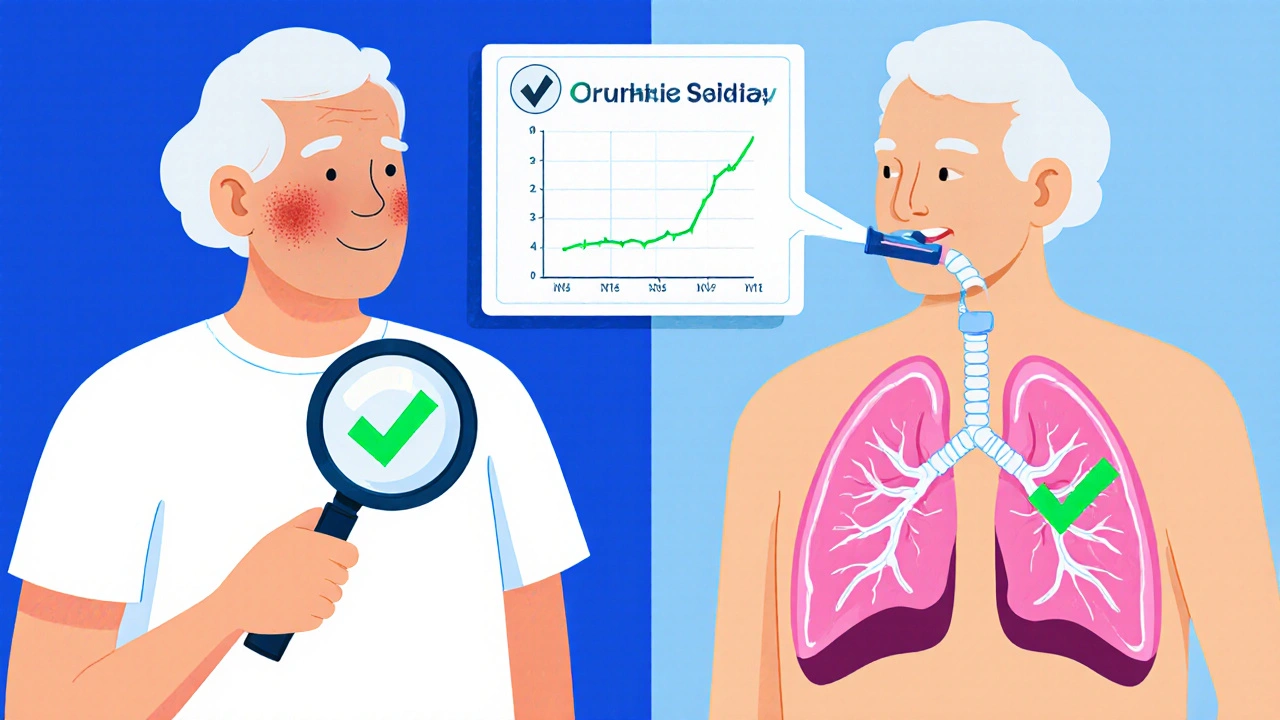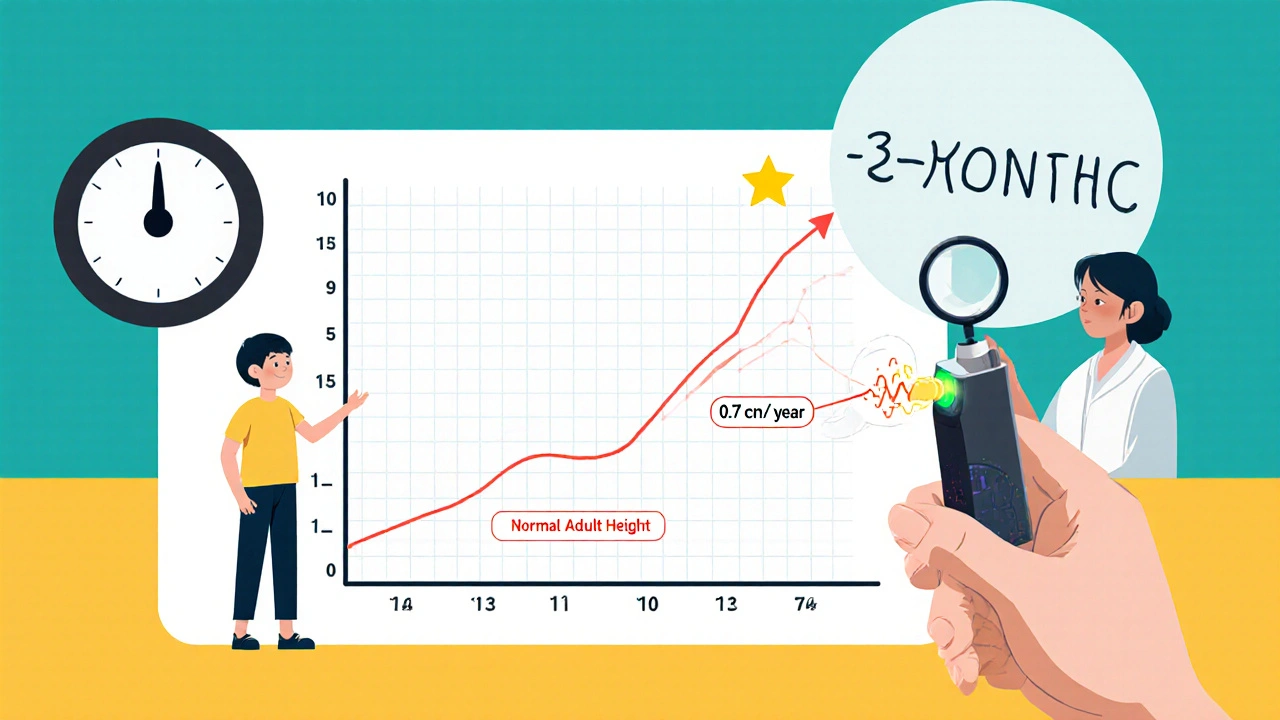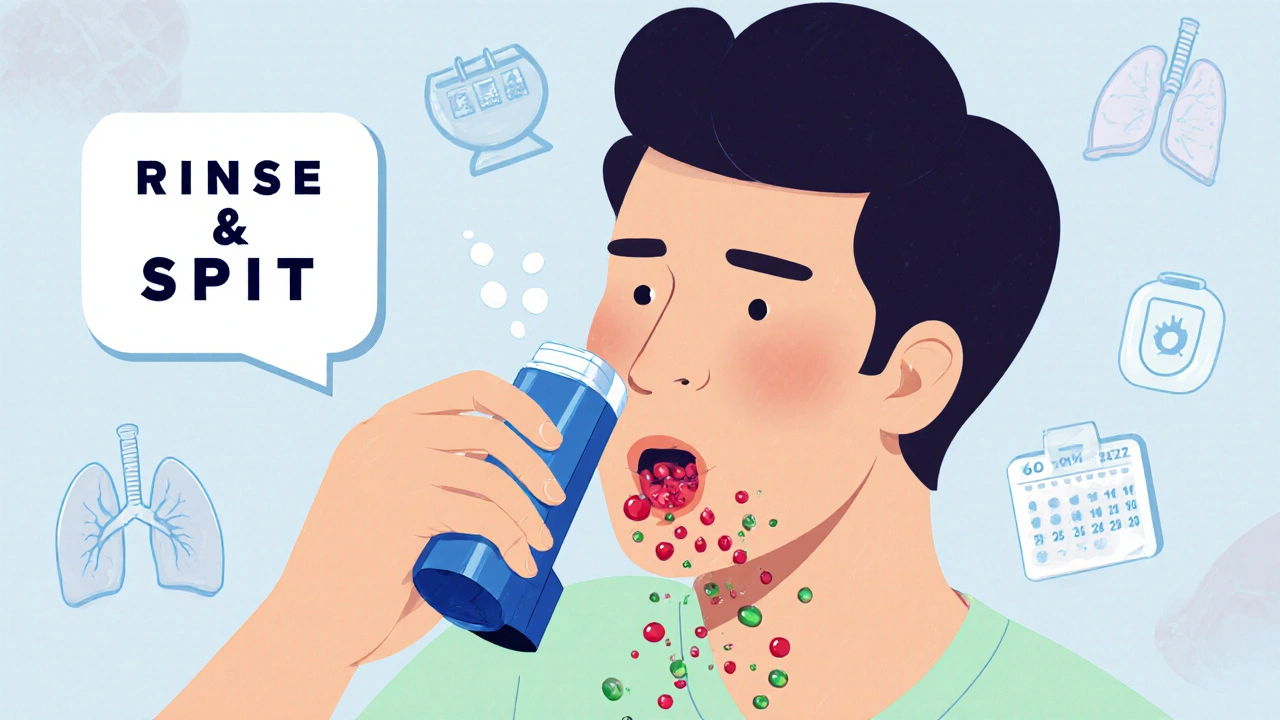For millions of people with asthma, inhaled corticosteroids (ICS) are the backbone of daily treatment. They work quietly inside the lungs to calm inflammation, prevent flare-ups, and keep breathing easy. But if you’ve been using them for months or years, you might have noticed a scratchy throat, a fungal infection in your mouth, or unexplained bruising. These aren’t rare accidents-they’re predictable side effects, and they’re manageable. The key isn’t stopping the medication. It’s using it smarter.
What Are Inhaled Steroids Really Doing?
ICS drugs like fluticasone, budesonide, and mometasone aren’t the same as oral steroids you might take for a flare-up. They’re designed to act locally in the airways, with minimal absorption into the bloodstream. That’s why they’re safer than pills-but not risk-free. Even small amounts that enter your system can cause problems over time, especially at higher doses.
Think of it like this: a spray that hits your lungs exactly where it’s supposed to is doing its job. But if you inhale too fast, don’t use a spacer, or forget to rinse your mouth, up to 80% of the dose can stick to your throat and tongue instead. That’s where side effects start.
Common Side Effects and Who’s Most at Risk
Most side effects from ICS are mild and local. Oral thrush-a white, patchy fungal infection in the mouth-is the most reported issue. Studies show 7% of users get it, but that number jumps to over 38% if they don’t rinse after using their inhaler. Voice changes (hoarseness or loss of tone) affect nearly 40% of long-term users. Throat irritation and coughing are also common.
But there are deeper risks. Skin thinning and easy bruising become noticeable after five or more years of high-dose use. One study found that people using over 1,000 mcg daily for five years had a 34% chance of significant skin thinning. That’s not a guess-it’s a measured outcome.
For older adults, the stakes are higher. High-dose ICS increases pneumonia risk by nearly 70% in people over 65. It also raises fracture risk by 31% in those over 60. Children aren’t immune either. While standard doses cause only a tiny, temporary dip in growth rate (about 0.7 cm per year), doses over 800 mcg daily in kids under 12 double the risk of cataracts.
Dose Matters More Than You Think
Not all steroids are the same. Fluticasone gets absorbed into the bloodstream at 30-40%. Budesonide? Only 10-15%. Ciclesonide? Just 2-3%. That’s why switching from fluticasone to ciclesonide can cut systemic side effects by more than half-without losing asthma control.
The threshold for risk isn’t the same across all drugs. For fluticasone, anything above 500 mcg daily starts increasing adrenal suppression. For budesonide, that same risk doesn’t show up until you hit 800 mcg. And if you’re on over 1,000 mcg of any ICS daily, you’re entering the same danger zone as oral steroids.
Doctors are trained to start low and go slow. But too often, patients stay on high doses long after their asthma is under control. A 2023 study found that 72% of people with side effects had never had their inhaler technique checked. That’s not negligence-it’s a system failure.

Four Proven Ways to Cut Side Effects in Half
You can’t eliminate risk completely-but you can slash it dramatically with four simple habits.
- Use a spacer every time. If you’re using a metered-dose inhaler (the kind that sprays), a spacer is non-negotiable. It catches the puff in a chamber so you can breathe it in slowly. Without one, only 10-20% of the medicine reaches your lungs. With one? That jumps to 60-80%. And your throat gets 70% less of the drug.
- Rinse and spit. After every puff, swish water in your mouth for 10 seconds and spit it out. Don’t swallow it. This simple step cuts thrush risk by 50-60%. It’s cheap, fast, and backed by 17 clinical studies.
- Use the lowest dose that works. Many people stay on the same dose for years, even after their symptoms disappear. GINA guidelines say to step down every 3-6 months if control is stable. If you’ve been symptom-free for six months, talk to your doctor about reducing your dose. You might be able to cut it in half.
- Get your technique checked every 3-6 months. Most people use their inhaler wrong-even if they’ve been doing it for years. A 2021 study found that 45-60% of users had at least one major error. Common mistakes: inhaling too fast, not holding breath long enough, or not coordinating the puff with the breath. A quick 5-minute check with your nurse or pharmacist can fix it.
Who Needs Extra Monitoring?
Not everyone needs the same level of oversight. But if you fit into one of these groups, you should be screened regularly:
- Over 65 and on high-dose ICS: Get a bone density scan every 2 years. Ask your doctor to check your skin for thinning or bruising at every visit.
- Children on ICS: Track height every 6 months. If growth slows more than 1 cm per year, reassess the dose.
- Pregnant women: Budesonide is the only ICS with strong safety data in pregnancy. Avoid fluticasone unless absolutely necessary.
- On over 500 mcg fluticasone equivalent daily for more than 6 months: Ask about a simple saliva test for cortisol. Low levels can signal adrenal suppression before you feel fatigued or dizzy.

New Tools Making Monitoring Easier
Technology is catching up. Smart inhalers now track when and how you use them. Some can even detect if you’re inhaling too fast or forgetting to hold your breath. In a 2023 trial, these devices improved technique by 85% in just three months.
Another breakthrough? Blood tests. If your eosinophil count (a type of white blood cell) is above 300 cells per microliter, you’re likely to stay controlled on half the usual ICS dose. That means you might be able to cut your medication without risking a flare-up.
And the future? New drugs like AZD7594 are in trials. They deliver the same anti-inflammatory power as fluticasone-but with 90% less systemic absorption. Non-steroid biologics like dupilumab are already helping severe asthma patients cut their ICS use by 70%.
What to Do Next
If you’re on an inhaled steroid:
- Ask your doctor: “Is this the lowest dose I can safely use?”
- Bring your inhaler to your next appointment and demonstrate how you use it.
- Start using a spacer if you aren’t already.
- Rinse and spit after every use-no exceptions.
- If you’re over 60, ask about bone density and skin checks.
- If you’re a parent, track your child’s height every 6 months.
ICS are powerful, life-changing tools. But they’re not harmless. The goal isn’t to fear them-it’s to use them with precision. Every puff counts. Every rinse matters. And every check-up could mean the difference between safe control and silent harm.
Can I stop using my steroid inhaler if I feel fine?
No-not without talking to your doctor. Feeling fine means the medication is working. Stopping suddenly can cause your airways to flare up again, sometimes severely. Instead, ask your provider about stepping down your dose gradually. Most people can reduce their dose by 25-50% after 3-6 months of stable control, but this must be done under supervision.
Is there a steroid inhaler with fewer side effects?
Yes. Ciclesonide and mometasone have much lower systemic absorption than fluticasone or beclomethasone. Studies show they reduce side effects like thrush, hoarseness, and adrenal suppression by 40-60% while keeping the same level of asthma control. If you’re on a higher-dose inhaler and experiencing side effects, ask your doctor if switching to one of these newer options is right for you.
Do spacers really make that much difference?
Absolutely. Without a spacer, up to 80% of your medication stays in your mouth and throat-where it causes side effects but doesn’t help your lungs. With a spacer, 60-80% reaches your airways. That means you get better asthma control with less medication, and you cut your risk of thrush and hoarseness by more than half. Spacers are cheap, reusable, and work with almost all inhalers.
I’m on a high dose. Should I be worried about adrenal problems?
If you’re taking more than 500 mcg of fluticasone (or its equivalent) daily for over 6 months, yes-you should be monitored. Adrenal suppression means your body stops making enough natural cortisol. Symptoms include fatigue, dizziness, low blood pressure, and nausea. A simple saliva cortisol test can detect this early. Don’t wait until you feel awful. Ask your doctor about testing if you’re on high-dose therapy long-term.
Are inhaled steroids safe during pregnancy?
Budesonide is the safest choice. It’s been studied in over 15 years of pregnancy registries and shows no increased risk of birth defects at standard doses. Fluticasone and mometasone are classified as Category C, meaning safety data is limited. If you’re pregnant or planning to be, talk to your doctor about switching to budesonide. Uncontrolled asthma poses a greater risk to your baby than the medication.
Can kids grow normally on steroid inhalers?
Yes, if they’re on the right dose. Studies show that standard doses (under 400 mcg daily of beclomethasone equivalent) cause only a tiny, temporary delay in growth-about 0.7 cm per year. This doesn’t affect final adult height. But doses over 800 mcg daily in children under 12 can increase the risk of cataracts and may slow growth more noticeably. Regular height checks and dose reviews are essential.
What if I can’t afford a spacer or my inhaler?
Many clinics and pharmacies offer free or low-cost spacers. Some insurance plans cover them. If your inhaler is too expensive, ask about generic versions-budesonide and fluticasone have affordable generics. Also, check with patient assistance programs from drug manufacturers. Never skip doses because of cost. Poorly controlled asthma leads to ER visits and hospital stays that cost far more.
Managing asthma with inhaled steroids isn’t about avoiding risk-it’s about controlling it. With the right technique, the right dose, and regular check-ins, you can breathe easy without paying a hidden price.
